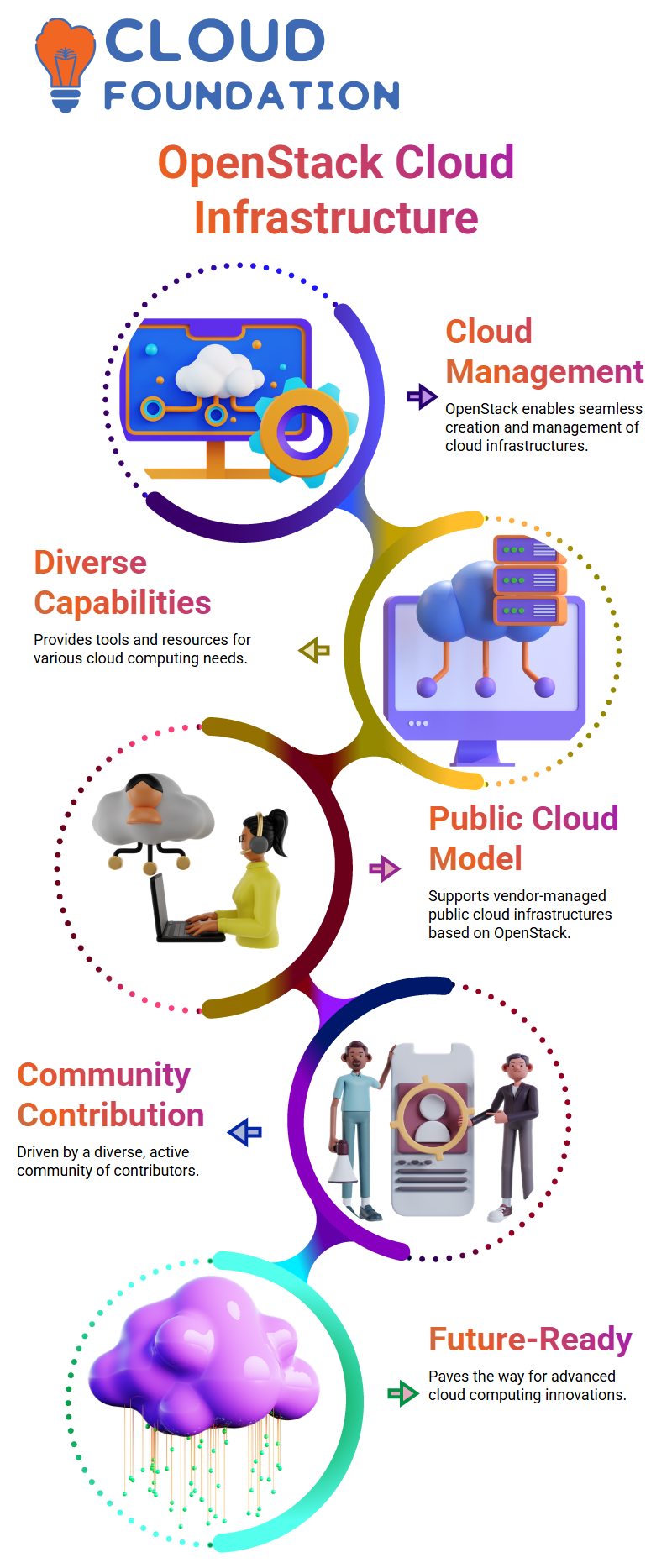OpenStack Tutorial
What is OpenStack
OpenStack is an indispensable platform for building and managing cloud infrastructure, offering everything from developing applications to providing a safe testing and production environment.
OpenStack offers businesses all of the resources and tools necessary for designing, creating and managing cloud infrastructures, setting the path toward future developments in cloud computing.
OpenStack-based public cloud is another type of public cloud model wherein vendors provide cloud services using this open-source project as their foundation for public cloud provisioning and maintenance. A vendor in this case would be accountable for creating infrastructure as well as offering necessary services through this approach.

Users can then request services from vendors and receive them.
OpenStack provides users with tools and resources for building and managing cloud infrastructures; as well as offering various components and services designed to suit individual user preferences and needs.
OpenStack Community is comprised of individuals from diverse backgrounds who collaborate on its development and maintenance, offering tools and resources for users to set up and manage cloud infrastructures.
Additionally, they provide an array of components and services tailored to the various needs and preferences.
The application in OpenStack
The Horizon dashboard
The Coom Meter
The Horizon is an interactive dashboard designed to allow users to launch and manage instances within their cloud infrastructure quickly and efficiently. It gives an overall snapshot of their virtual machines.
The Coom Meter is part of the Telemetry project of OpenStack, which is used to check the uptime, availability, and usage of services on the system.
Bills or logs of services availed are created, providing an audit trail of their usage. Heat orchestration software will run multiple applications that utilize OpenStack infrastructure services.
Importance of OpenStack
OpenStack community members include Giants of tech, such as Facebook founder Mark Zuckerberg and other top tech industry names who make significant contributions towards its development and maintenance. Furthermore, OpenStack encompasses developers as well as users working towards cloud infrastructure development.
OpenStack is supported by an extensive variety of technologies and widely seen as the future of cloud computing. OpenStack enables users to develop, deploy, manage, and track applications across numerous cloud platforms.
OpenStack makes its presence felt in the cloud through its usability; users can utilize it to set up their infrastructure such as servers, storage devices and data backup solutions in one simple platform.
Customers can utilize this platform to design, develop and manage applications such as websites, mobile applications and web services.
Cloud computing in OpenStack
Cloud computing is an innovative approach to access and utilize various applications and data across devices. By layering a virtualisation layer over servers, users are easily able to utilize services provided by cloud services as well as access the data stored therein.

Cloud computing refers to an internet-based form of computing in which servers located globally are equipped with virtualisation layers for maximum flexibility and capacity maximisation.
Services and processing can be shared across devices for various individuals to access and utilize, ensuring access to services provided by cloud platforms for multiple individuals.
Cloud computing refers to storing and managing information within an online environment known as “The Cloud.”
Infrastructure as aService (IaaS)
Platform as a Service (PaaS)
Software as a Service (SaaS)
Infrastructure as a Service (IaaS): Infrastructure as a Service refers to infrastructure provided via servers, virtualisation software and middleware services.
Installation includes operating systems, middleware, application, and data management solutions.
Platform as a Service (PaaS): is another type of service which offers users the platform necessary for developing applications, like Gmail or Google Drive, securely over time. It enables access and management of applications like these through one simple platform – like Gmail or Drive are examples.
These services allow users to easily and securely manage and access their applications and data, helping develop infrastructures more quickly and securely.
Software as a Service (SaaS) offers users access and management of applications and data remotely – similar to Gmail or Google Drive – from any location worldwide. Such services aim to offer seamless experience for users by giving them quick, seamless access and administration of applications/data efficiently.
Avail in OpenStack
Avail is an open stack platform, offering users the capability of building applications and infrastructure within the cloud. A variety of deployment models exist such as on-premises, distributed hosting, hosted services and OpenStack private.
On-premise data centers refers to facilities located within an organization where servers are managed and hosted within its walls.
On-premises distribution
Open-stack
Open-stack private
Hybrid cloud.
On-premise data centers refers to facilities located within an organization where servers are kept and managed directly by them.
On-premises distribution can be implemented as layers of open, open-stack and private infrastructure that create both public and private infrastructures.
OpenStack private Cloud is a hybrid cloud, meaning some portions are public while some remain private.

Used correctly, hybrid clouds offer many benefits and allow companies to develop private/public hybrid services.
OpenStack architecture
OpenStack architecture comprises various components that form its platform. These components include the OpenStack dashboard, Horizon, Keystone and other services – Horizon provides user interface while Keystone serves authentication needs.
OpenStack architecture consists of various layers. Nova, as the compute domain, Glance, Swift Storage Service Neutron Network Service Cinder Block Heat.
OpenStack architecture is a comprehensive system designed to manage various services and features within its platform, in order to keep its many components functioning effectively.
OpenStack architecture includes an Authentication Service which authenticates every service accessible in OpenStack, such as images or computing network storage services, so they remain accessible. This ensures every aspect of OpenStack services remains accessible.
Multi-tenant authorisation in OpenStack
Multi-tenant authorisationis an essential feature of OpenStack, implemented through its Identity API. Users can authorise multiple tenants with credentials which allow for authentication across different tenants.
Users can easily gain access to services they require, including API clients, service discovery mechanisms and distributed features, multi-tenant authorization capabilities and multi-tenant authorization features.
Keystone in OpenStack
Keystone is a cloud-based service that enables users to gain access to and manage various services using token authentication and user credential management.
Keystone provides two services – token management and catalog – which validate and manage tokens used for authentication of requests, respectively; catalog also acts as an endpoint and registry registry, with keystone itself utilising discovery services via OpenStack endpoints to connect discovery services together.
Keystone catalog endpoints enable users to easily connect with various endpoints for services and receive services, and access can be granted only to authorized users or specific individuals as desired. They can verify if each connection can be approved individually for users who require authorization before proceeding further with it.
Keystone is an essential feature of our policy service, enabling users to obtain permissions necessary for making changes and assigning privileges. By making use of Keystone users can ensure their services remain safe and efficient allowing them to manage resources effectively and access services efficiently.
Nova compute zone in Openstack
Nova compute zone is an essential element of Nova system where all processes run within OpenStack. Built upon a messaging architecture, its components may run simultaneously across different servers.
A message broker system (typically middleware-like), allows a message queuing system to communicate with every component in Nova, including scheduling jobs to be executed within its compute zone and communicating them using message broker system. A scheduler manages these jobs through message broker.
Nova is where all processing in OpenStack takes place; its messaging architecture means its components can run on separate servers.

All microservices or components communicate using message queueing systems like RabbitMQ for message exchange between microservices or components within it.
Neutron in Openstack
Neutron is an effective method for creating subnets and managing data within OpenStack, providing users with secure networks. Swift proxy plays an integral part of its architecture to facilitate quick retrieval and management of information.
Neutron stands out as an efficient storage and management platform with robust features and user-friendly functionality, making it the go-to option for organizations aiming to store and organize data efficiently.
Neutron is a Network as a Service (NaaS) solution which enables users to easily create subnets and form custom networks of their own, while at the same time serving to store various files, images, or data types.
Swift is an object storage solution available through OpenStack that helps organisations store large volumes of information safely and efficiently.
Neutron API in Openstack
Neutron API is an essential element of OpenStack, providing seamless communication among various services and processes. Its architecture was specifically developed to ensure all services were managed effectively.
Neutron API is an OpenStack networking component and stands alone as a standalone service within its platform. It connects various services like Nova, I, and Horizon that form part of Nova framework.
Neutron is a messaging protocol utilized by the Neutron API to communicate with other services. RabbitMQ serves as its messaging broker of choice in this instance.
Neutron deployment involves running several processes on each host and allocating different ones for specific services. Each host is also given its own controller host which manages authentication and services running across hosts.
Cinderin Openstack
Cinder is an object and file storage system, providing users access to them from any external hard disk drive. Utilising pluggable storage solutions enables users to manage memory efficiently while easily accessing objects within it without being concerned with where exactly they reside in memory.
Lost items cannot always be recovered through memory alone; using blog storage services allows users to attach files directly to posts for continuous availability and accessibility.
Cinder is a database management system designed to allow users access various services like Nova, Swift and Keystone on OpenStack platforms.
Conclusion
OpenStack stands as an invaluable platform in cloud computing, giving businesses and organisations all of the tools necessary to efficiently design, construct, manage, and scale their cloud infrastructure.

By combining open-source software’s flexibility with an extensive ecosystem of tools and services, OpenStack empowers users to easily deploy any number of apps while managing infrastructure effortlessly. Its large community of contributors, it continues to advance cloud technologies while driving innovation forward.
OpenStack offers an adaptable, secure and scalable cloud infrastructure solution designed for today’s demanding cloud environments.
As cloud computing becomes an integral component of modern society, OpenStack’s role as an infrastructure and application solution provider for developers, businesses, and enterprises will only increase. OpenStack serves a diverse set of infrastructure requirements with ease making it an indispensable asset.

Vinitha Indhukuri
Author



